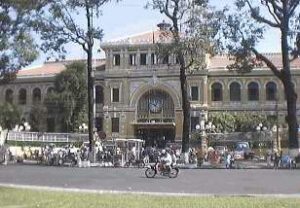Home » History of Vietnam » Early History » Policy of Doi Moi
Policy of Doi Moi
The moment the rain tapers off in Ho Chi Minh City, adolescent street hawkers re-emerge from beneath the awnings to continue their endless search for new customers. Ten year olds selling lottery tickets run from food stalls to tailor shops, looking for people who believe that today might be their lucky day. Them commuters peer out from under the eaves, wipe pools of water from the new Honda motorbikes, and roar off into the sprawling arms of the metropolis. One Hanoian resident living in Ho Chi Minh City complains, “this city has no soul.” But natives turn defensive at the suggestion that they have no depth. They may seem preoccupied with commerce and fashion, but they also have romance and sentimentality, and at their heart, they have Saigon.

Ho Chi Minh City includes a dozen thriving commercial districts with different names, and at the center is Saigon-District One-with its old French villas, wide open streets, and an avenue of boutiques running from the Notre Dame Cathedral to the river. Ho Chi Minh City is a vibrant, exciting economic tiger. But everyone still calls the city Saigon and, as everyone knows, Saigon is not only a place for commerce, but for experience.
Ho Chi Minh City is young and hopeful and on the move. It has been almost a decade since Hanoi introduced doi moi, a collection of reforms and new attitudes that essentially released VietNam from the doctrinaire approach to socialism which Ho Chi Minh’s contemporaries had pursued since the revolutionary leader’s death in 1969. Meaning renewal, doi moi opened Vietnamese society in unprecedented ways, by allowing foreign investment and greater freedoms of expression. It has permitted the Vietnamese to own and operate their own business and, perhaps most importantly, earn money for themselves.
It is this new opportunity that infuses the air in Ho Chi Minh City. Not that the Vietnamese actually needed any encouragement. The entrepreneurial spirit seems almost second nature to most of them. It’s just that before doi moi, they had to pursue money-making behind closed doors, under the dark cloud of the black market. Now it’s all legal, and the rush to get to the marketplace is furious. It is not uncommon to see men and women holding down two or three jobs, or working on construction sites long past midnight, their efforts illuminated by only a few bare bulbs and the blue spark of a welder’s gun. But doi moi is not only about making money. It is about enjoying it, by seeing what the world has to offer, by testing the limits of change. Now that the country has opened its doors, a period of experimentation has begun, especially among those who are under 21, which, by recent count, is almost half the country.
On Teacher’s Day (a national favorite), on Reunification Day, on Christmas, and to a lesser extent every Sunday night, the downtown streets of Ho Chi Minh City are packed with young people having fun. They deck themselves out in glitter duds, striking poses while moving at 25 m.p.h. on their 70cc Honda motorbikes. Boys with James Dean hairdos and dangling cigarettes loosen their shoulders to whip like snakes through traffic. The girls ride behind, chatting, sometimes sidesaddle and at ease, poised cross-legged, as if at a debutante ball.
True, VietNam is an ancient country, with thousands of years of tradition behind it. But in Ho Chi Minh City, and increasingly in Hanoi, the old blends with the new in surprising ways. I asked a resident once if he liked the ao dai, the Vietnamese woman’s traditional dress. Though noticeably transparent, the white ao dai has somehow become the high school uniform in Ho Chi Minh City.
“Of course I like ao dai” he said. “I am Vietnamese!”
“And why do Vietnamese like the ao dai?” I asked.
“The ao dai,” he said, “is part mystery, part revelation.”

Indeed, it seems as though tradition is unable to hold young Vietnamese down. As indo-chic struts down fashion show runways in Paris, the youth of Ho Chi Minh City are trying out the rudiments of MTV vogue, albeit slightly outdated, and learning to dress like Madonna and Stevie Nicks or Sid Vicious and Don Johnson all at once. The cruising teenagers seem unconcerned that, for their parents, the air is cluttered with ghost. The youth can barely remember the war. How could they be bothered by it? Their parents, though, begin every other sentence with ‘Before 1975…” And end it with nostalgia: from their own youth, for excitement, even for the old French names of the tree-lined boulevards.
Saigon was always a market for the commodities of pleasure. Although today’s Ho Chi Minh City is too busy to look back, it isn’t too busy to have fun. Everywhere are garden cafe’s with dark hideaways, and discos where swanky singers in miniskirts croon slow-dance ballads under dreamy blue neon, and “taxi-dancers” wait for single men as they have been waiting for twenty years. The people of the city live in a generous world. They have an expression, “Five won, five lost.” It means: Relax, take a chance. You may lose but you’ll always win again. If you get a chance go visit the beautiful city of Saigon.

